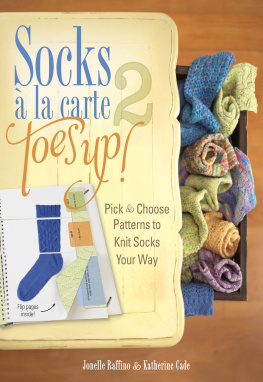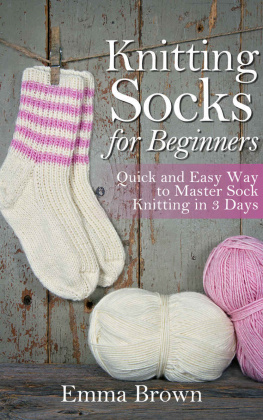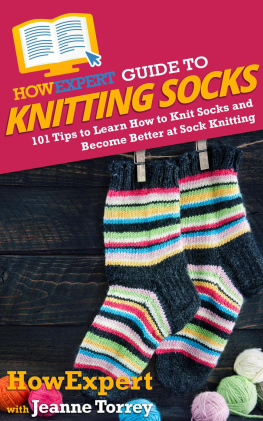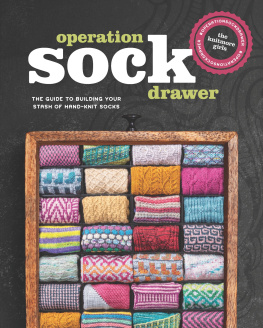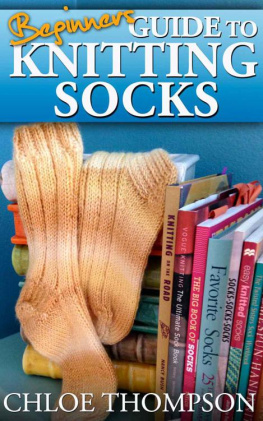Dedication
To knitters everywhere who have made the socks that never cease to inspire me.
Contents
Introduction
Why Knit Socks?
Why do you knit socks?
Almost everyone who knits socks has been asked this question. The next question, usually asked by a non-knitter with a furrowed brow and incredulous tone of voice, is, Is it cheaper than buying them?
Definitely not. These days you can buy socks for a few dollars a pair, quite a bit less than the cost of a skein of sock yarn. But the product you can buy for three dollars at your local discount store cant compare with the pair of socks you can make by hand, even with the least expensive sock yarn available.
Comfort is one reason to knit your own socks. There is nothing as comfortable and cozy as wearing a pair of handknit socks. Whether you choose warm wool for winter wear, heavy yarn for slippers, luxury sock yarn to wear while reading in bed, or cotton sock yarn for spring and summer (or Southern) wear, your handknit socks will be the most comfortable socks you have ever worn.
Socks are also a lot of fun to make. You can stick with a ).
Commercial socks are sold in just a few sizes. For adults, stores typically carry just one average size for men and one for women. The choice isnt always straightforward, and you might not even be able to find socks that fit you properly. I wear a womens size 11 shoe (thats size 42 in Europe), so socks sold for women are usually too small for me, while socks sold for men are too big. When I make my own, they always fit just right.
Another reason to knit socks is to use the amazing sock yarns that are on the market today. Of course, you can use these yarns to make sweaters, shawls, and other accessories, but a sweater made of sock yarn, knit at 7 or 8 stitches per inch, could take a year to finish! Using sock yarn can be quite expensive for knitting shawls. And heavier yarns are often more practical for winter accessories like scarves, hats, and mittens. With just one skein of sock yarn (about 400 yards), you can make a whole pair of socks to fit an adult, or two pairs of kids socks! And you can finish in a couple of weeks, or maybe even less.
Socks make wonderful gifts, too. Who would turn their nose up at a warm, comfy pair of socks? Whether showing them off in clogs (or sandals), wearing them inside winter hiking boots, or cuddling in front of the fire on a cold winters evening, anyone who receives a present of handknit socks will appreciate the effort and love the gift.
Before you get started, I must warn you: knitting socks is addicting! Once you make your first pair, youll be hooked, and before you know it, people will be asking you, Why do you knit socks? But with all of these benefits, the real question is, Why not knit socks?
Chapter One
Yarn for Knitting Socks
There are many different kinds of yarn that can be used for knitting socks. Not only are there different weights, or thicknesses, of yarns, but yarns are made from different fibers, dyed in both solid colors and multicolored patterns, and spun with different textures. Choosing the right yarn for your sock project is key to being happy with the end results.
Yarn Weights
Yarn that is called sock yarn by yarn manufacturers is usually fingering weight, also called 4-ply in the United Kingdom. The way yarns are categorized can be quite confusing, because even though there is a standard U.S. yarn weight system, most knitters use older names to describe the weight (which in this context refers to thickness, not actual weight), of yarn. The table below includes the Craft Yarn Council (CYC) standard yarn weight system, as well as common U.S. and U.K. names for the same yarns, along with gauge information, a suggested needle size range, and information about the types of socks that can be knit with each weight of yarn. While there are yarns that are both thinner and thicker than those Ive listed here, I havent used them for knitting socks.
Standard Yarn Weights for Socks

This information is from the Craft Yarn Council Standard Yarn Weight System guidelines ( www.craftyarncouncil.com ).
Fiber Content
In addition to yarn weight, the fiber used to create a yarn is an important factor in the suitability of yarn for knitting socks. All yarns come from one of three sources: animals, plants, and chemistry (man-made materials).
Fibers from Animals
Protein, or animal-source, fibers make warm, breathable yarns that are easy to knit because the fibers have natural give, or stretch. Depending on the type of animal and specific breed, yarns from animal fibers can be soft enough to place next to a babys skin or strong enough to wipe your feet on.
Using the Chart
The guidelines in the yarn-weights table on the facing page are based on my preferences and experience. If you check the CYC guidelines, youll notice that they suggest both a looser gauge and larger needles for each yarn weight because the CYC guidelines are generic; my numbers are specifically for knitting socks. You may find patterns that are knit at different gauges than listed here, and you may need to use different needle sizes to get your desired gauge. (For more information about this, see .)
Wool is the most common animal fiber and comes from the fleece of sheep. Wool is warm and breathable and can absorb up to 30 percent of its weight in water without feeling wet, which makes it exceptionally practical for socks. Merino wool is the softest available and is quite popular in sock yarns; however, it is not the strongest of wool fibers for the same reasons it is soft: it has short, fine individual fibers. Merino sock yarns are almost always blended with nylon for added strength. Other breed-specific yarns such as Bluefaced Leicester, Polwarth, Romney, and others have become more popular of late and can now be found at fiber festivals, as well as online and at local yarn shops. Many sock yarns are made with wool from various meat- and fiber-sheep breeds, are often blended together, and do not list the specific breeds on the label.
Alpaca and llama fibers are spun into yarns that are similar to wool but have less elasticity. These yarns can be very soft, but they are usually denser and weigh more than wool yarns of the same thickness. These fibers are not as springy as wool, so the knitted fabric is not as stretchy, but they can be used successfully in combination with knitting stitches such as ribbing that add elasticity to the sock. When blended with wool, alpaca and llama make very warm socks for winter wear, as well as long-wearing hiking and work socks.
Cashmere yarn is made from the downy undercoat of Angora goats. This fiber, as well as other luxury fibers made from down fibers, such as qiviut (from the musk ox), bison, yak, and camel, are not strong enough for long-wearing socks but can be used for socks when blended with wool and nylon for strength.
) to keep the yarn from shedding, even when blended with wool. A few high-twist angora-and-wool-blend yarns are on the market today, and these are excellent for extra-warm socks and slippers.


